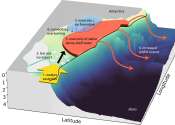New evidence for liquid water beneath the south polar ice cap of Mars
An international team of researchers has revealed new evidence for the possible existence of liquid water beneath the south polar ice cap of Mars.

An international team of researchers has revealed new evidence for the possible existence of liquid water beneath the south polar ice cap of Mars.
Astronomy
Sep 29, 2022
0
247

(Phys.org) —With data collected from the mighty W. M. Keck Observatory, California Institute of Technology (Caltech) astronomer Mike Brown—known as the Pluto killer for discovering a Kuiper-belt object that led to the ...
Astronomy
Mar 5, 2013
8
0

(PhysOrg.com) -- NASA's Mars Reconnaissance Orbiter has discovered the total amount of atmosphere on Mars changes dramatically as the tilt of the planet's axis varies. This process can affect the stability of liquid water, ...
Space Exploration
Apr 21, 2011
5
0

Ocean temperatures have been off the charts since mid-March 2023, with the highest average levels in 40 years of satellite monitoring, and the impact is breaking through in disruptive ways around the world.
Environment
Jun 21, 2023
0
152

From abstract-looking cloud formations to roars of snow machines on ski slopes, the transformation of liquid water into solid ice touches many facets of life. Water's freezing point is generally accepted to be 32 degrees ...
Analytical Chemistry
Mar 20, 2024
0
112

Earth's oceans are a complex system, and their interconnected nature has global implications. Around Antarctica, cold and dense waters form in the depths of the Southern Ocean. This is known as Antarctic Bottom Water (AABW). ...

Nature doesn't conform to our ideas of neatly-contained categories. Many things in nature blur the lines we try to draw around them. That's true of Jupiter's moon Ganymede, the largest moon in the solar system
Astronomy
Oct 27, 2023
0
38

NASA is sending a mobile robot to the South Pole of the moon to get a close-up view of the location and concentration of water ice in the region and for the first time ever, actually sample the water ice at the same pole ...
Space Exploration
Oct 28, 2019
0
213

(Phys.org) —A team of researchers from the Netherlands, led by Richard Bintanja, has published a paper in the journal Nature Geoscience, contending that the reason the amount of annual Antarctic sea ice is increasing is ...

The most likely source of the water locked inside soils on the moon's surface is the constant stream of charged particles from the sun known as the solar wind, a University of Michigan researcher and his colleagues have concluded.
Space Exploration
Oct 14, 2012
8
2